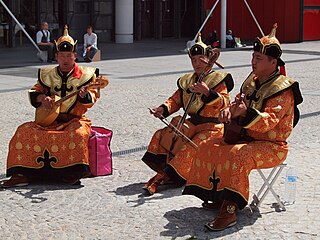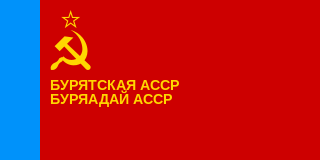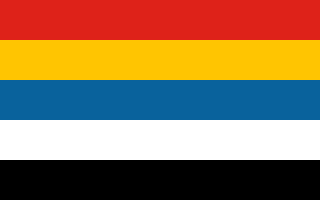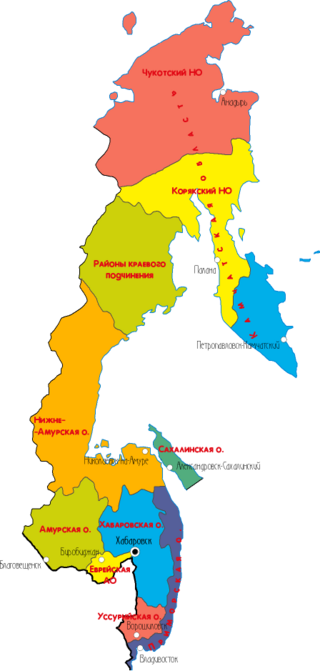
The Mongols are an East Asian ethnic group native to Mongolia, China, as well as Buryatia and Kalmykia republics of Russia. The Mongols are the principal member of the large family of Mongolic peoples. The Oirats and the Buryats are classified either as distinct ethno-linguistic groups or subgroups of Mongols.

The Buryats are a Mongolic ethnic group native to southeastern Siberia who speak the Buryat language. They are one of the two largest indigenous groups in Siberia, the other being the Yakuts. The majority of the Buryats today live in their titular homeland, the Republic of Buryatia, a federal subject of Russia which sprawls along the southern coast and partially straddles Lake Baikal. Smaller groups of Buryats also inhabit Ust-Orda Buryat Okrug and the Agin-Buryat Okrug which are to the west and east of Buryatia respectively as well as northeastern Mongolia and Inner Mongolia, China. They traditionally formed the major northern subgroup of the Mongols.

Ulan-Ude is the capital city of Buryatia, Russia, located about 100 kilometers (62 mi) southeast of Lake Baikal on the Uda River at its confluence with the Selenga. According to the 2021 Census, 437,565 people lived in Ulan-Ude; up from 404,426 recorded in the 2010 Census, making the city the third-largest in the Russian Far East by population.

Irkutsk Oblast is a federal subject of Russia, located in southeastern Siberia in the basins of the Angara, Lena, and Nizhnyaya Tunguska Rivers. The administrative center is the city of Irkutsk. It borders the Republic of Buryatia and the Tuva Republic in the south and southwest, which separate it from Khövsgöl Province in Mongolia; Krasnoyarsk Krai in the west; the Sakha Republic in the northeast; and Zabaykalsky Krai in the east. It had a population of 2,370,102 at the 2021 Census.

Buryatia, officially the Republic of Buryatia, is a republic of Russia located in the Russian Far East. Formerly part of the Siberian Federal District, it has been administered as part of the Far Eastern Federal District since 2018. It borders Irkutsk Oblast and Lake Baikal, the deepest lake in the world to the north, Zabaykalsky Krai to the east, Tuva to the west and Mongolia to the south. Its capital is the city of Ulan-Ude. It has an area of 351,300 square kilometers (135,600 sq mi) with a population of 978,588. It is home to the indigenous Buryats.

Buryat or Buriat, known in foreign sources as the Bargu-Buryat dialect of Mongolian, and in pre-1956 Soviet sources as Buryat-Mongolian, is a variety of the Mongolic languages spoken by the Buryats and Bargas that is classified either as a language or major dialect group of Mongolian.

The Buryat Autonomous Soviet Socialist Republic, abbreviated as Buryat ASSR, was an autonomous republic of the Russian SFSR within the Soviet Union.

Zabaykalsky Krai is a federal subject of Russia, located in the Russian Far East. Its administrative center is Chita. As of the 2010 Census, the population was 1,107,107.

Pan-Mongolism is an irredentist idea that advocates cultural and political solidarity of Mongols. The proposed territory, called "Greater Mongolia" or "Whole Mongolia" usually includes the independent state of Mongolia, the Chinese region of Inner Mongolia, and the Russian region of Buryatia. Sometimes the autonomous republic Tuva, the Altai Republic and parts of Xinjiang, Zabaykalsky Krai, and Irkutsk Oblast are included as well. As of 2006, all areas in Greater Mongolia except Mongolia have non-Mongol majorities.

The occupation of Outer Mongolia by the Beiyang government of the Republic of China after the revocation of Outer Mongolian autonomy began in October 1919 and lasted until 18 March 1921, when Chinese troops in Urga were routed by Baron Roman von Ungern-Sternberg's White Russian and Mongolian forces. These, in turn, were defeated by the Red Army and its Mongolian allies by June 1921.

Far Eastern Krai was a krai of the Russian Socialist Federative Soviet Republic of the Soviet Union from 1926 to 1938. Its capital was Khabarovsk. It was the largest administrative-territorial unit of the Soviet Union after the Yakut Autonomous Soviet Socialist Republic and the Kazakh Soviet Socialist Republic, occupying 12% of its territory. On October 21, 1938, the Far Eastern Krai was divided into Khabarovsk and Primorsky Krais.

Rinchinei Elbegdorzho was a Buryat nationalist revolutionary who played leading roles in the Outer Mongolian Revolution of 1921 and the early political development of the Mongolian People's Republic. He was an important member of the Mongolian People's Revolutionary Party representing the Buryats and served as Chairman of the Revolutionary War Council of the Mongolian People's Army.

Buddhism in Buryatia, a region in Siberia, Russia, has a deep-rooted history dating back to the 17th century when Tibetan Buddhism first arrived in the area. Initially adopted by ethnic groups like the Selenga and Zede Buryats, Buddhism gradually spread throughout the Transbaikal region. In 1741, it gained formal recognition as an official religion in the Russian Empire, with the establishment of Buddhist monastic universities known as datsans. Despite facing significant challenges during the Soviet era, including persecution and the closure of religious institutions, Buddhism in Buryatia has persisted and experienced a revival in the post-Soviet period.
The Central National Committee of the Buryat-Mongols of Eastern Siberia, generally known by its abbreviation Burnatskom (Бурнацком), was an organization of Buryat people in Russia during the Russian Revolution.
Anarchism in Mongolia was present during the revolutionary period of the 1910s and 1920s, closely linked with the Russian anarchist movement in Altai, Buryatia and Tuva.

Dorzhi Banzarov was a Buryat Orientalist and linguist. He is generally considered to be the first Buryat academic.
The Buryat liberation movement is the centuries-long social and military confrontation of ethnic Buryats against the Russian Empire, which actually colonized the region. In modern history - rallies and actions against the policy of the Russian Federation.
The Buryat-Mongolian People's Party was a nationalist political party in the Russian republic of Buryatia, active from 1990 to 2001.
Buryat Genocide - repressions, ethnic cleansing, mass forced resettlement by the Russian Empire, the Soviet Union and the modern Russian Federation against the Buryat people.













